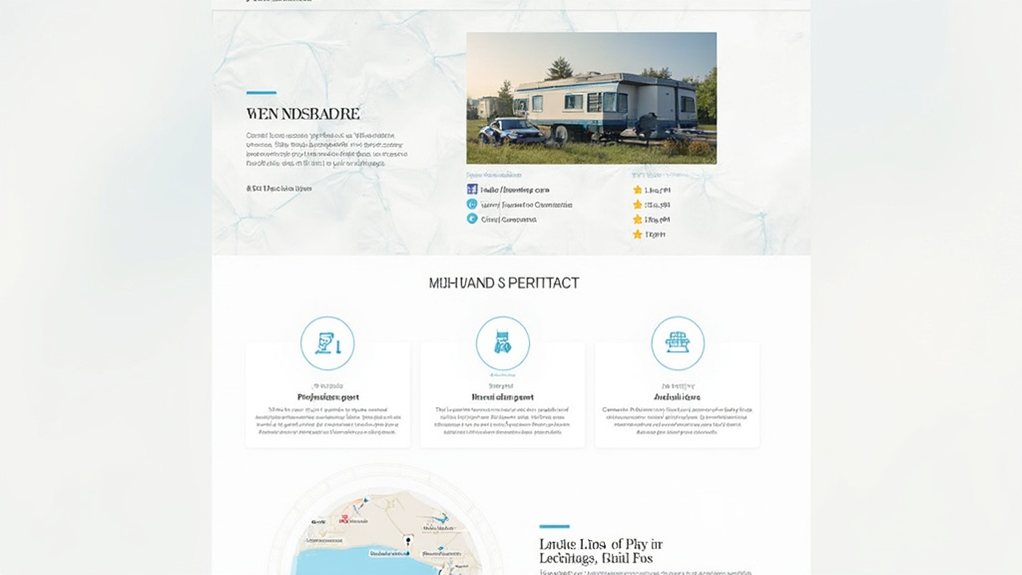To structure effective location-based service pages, you'll need to optimize your local business listings with accurate NAP details and rich media. Develop geo-targeted content strategies that incorporate location-specific keywords and create landing pages tailored to your target audience. Leverage structured URLs and compelling on-page content to improve search visibility and user engagement. Embed interactive maps and directions to enhance the overall experience. By taking these steps, you'll be well on your way to building a strong online presence for your local business. But there's more to discover about optimizing location-based pages…
Optimizing Local Business Listings

Ensuring your local business listings are optimized is crucial for boosting visibility and driving potential customers to your doorstep. Maintain accurate and consistent NAP (Name, Address, Phone Number) across directories to enhance trust with search engines. Local business listings can include website URL, business category, photos, videos, and overview to provide a better customer experience. Create unique, location-specific descriptions for your Google Business Profile to improve local rankings. Optimizing listings with relevant keywords will aid discovery by potential customers. Inaccurate information can discourage 63% of consumers from choosing your business, so regularly update your information across all platforms to maintain credibility and visibility. By taking these steps, you'll strengthen your local SEO and connect with more potential customers in your area.
Developing Geo-Targeted Content Strategies

Incorporating geo-modifiers into your content titles and descriptions is a crucial step in improving local SEO relevance. This involves including location-specific keywords to align with user searches. Additionally, focusing your blog content on local events, industry news, and answering local queries increases its relevance to local audiences. Creating location-based landing pages enhances user engagement by providing location-relevant information. Streamlining the process of creating geo-targeted pages can be achieved through the "Smart Content" method, which automatically adjusts content to fit multiple locations. Utilizing location-based targeted ads can further enhance visibility and reach for local audiences.
Interlinking local SEO pages with nearby locations helps improve visibility in search results. Adding geo-tags to website images and content aids search engines in associating your business with specific locations. Acquiring links from local directories boosts visibility and authenticity for local audiences. Tailoring content based on location can increase engagement by making interactions more relevant and timely.
Structuring Effective Location Page URLs

Consistent URL structures are key when it comes to creating effective location pages. Use a standardized naming convention across all location-specific pages to help users and search engines understand your content hierarchy. Incorporating relevant local keywords into your URLs can enhance visibility in searches. Keep your URLs simple and concise, using hyphens instead of underscores. Organize your URLs by geographic location when possible, grouping location pages under a 'locations' category. Finally, enhance your location pages with schema markup to provide search engines with more context about your business and improve their visibility in results.
Crafting Compelling Location Page Content
When crafting compelling location page content, it's essential to focus on tailoring the information to the specific needs and interests of your local audience. Incorporate relevant local keywords to ensure your content resonates with your target demographic. Ensure consistent NAP details, and provide unique location-specific content to differentiate each page. Enhance the user experience with clear CTAs, accurate opening hours, and easily digestible content. Leverage schema markup to improve search visibility and build credibility through customer reviews and team highlights. By following these best practices, you can create location pages that engage your target audience and drive meaningful actions.
- Target local keywords
- Maintain NAP consistency
- Focus on location-specific info
- Utilize quality visual elements
Embedding Interactive Maps and Directions
Embedding interactive maps can enhance the navigability of your location-based pages. Integrating detailed directions also ensures accessibility for users who may have trouble with GPS. Utilizing visual aids like points of interest can further improve the overall user experience. Providing parking information can alleviate stress for visitors arriving at the location.
Enhance Navigability With Maps
Why not enhance your website's navigability with interactive maps? Embedding maps can significantly improve user experience, credibility, and search engine optimization. Here's how:
- Increased Engagement: Interactive maps encourage users to explore and stay longer on your site. Interactive maps can captivate visitors, encouraging them to stay longer and explore more.
- Enriched Content: Maps can integrate multimedia content, telling visual stories about your business.
- Local SEO Boost: Embedding maps on location pages can improve your visibility in local search.
- Customizable CTAs: Maps can include call-to-actions to drive leads and customer interactions.
Integrate Directions for Accessibility
Integrating interactive maps and directions on your website can significantly enhance accessibility and user convenience. Offering step-by-step directions improves the user experience by providing clear navigation paths. Integrating real-time updates, like traffic alerts, further enhances user convenience. Customized interactions, such as arrival times, increase user satisfaction. Embedding dynamic maps encourages user engagement and interaction with your business location, boosting SEO through additional backlinks and a robust Google Business profile. Leveraging location data can enable seamless indoor navigation, as precise indoor mapping technologies like Wi-Fi-based positioning and BLE beacons enable seamless navigation in complex environments, improving overall accessibility and user trust in your services.
Visual Aids for User Experience
Interactive maps can serve as powerful visual aids, elevating the user experience on your website. They enhance engagement, offer enhanced data visualization, provide real-time updates, and allow for customizable views. Tailored user experience improves engagement and conversion rates Consider prominently embedding these maps, ensuring a user-friendly interface that aligns with your brand's design. Incorporate interactive features like pop-ups and animations to further engage your audience. Regularly test and iterate based on user feedback and analytics to optimize the experience.
- Improved Engagement
- Enhanced Data Visualization
- Real-Time Updates
- Customizable Views
Leveraging Customer Reviews and Testimonials
Tapping into the power of customer reviews and testimonials can help elevate your location-based service pages. Featuring positive feedback from local customers builds credibility and influences potential clients in that area. Highlight relevant testimonials that showcase your unique service offerings and address the specific needs of that community. [Monitoring and responding to Google reviews, both positive and negative, demonstrates your commitment to customer satisfaction and helps improve local SEO.] Aligning your location-specific content with customer feedback ensures your services are tailored to regional preferences. By effectively managing reviews, you can leverage valuable insights to enhance consistency and responsiveness across your multiple locations. Utilizing location-based customer feedback can further optimize the content and offerings for each of your business locations.
Establishing a Robust Internal Linking Structure
Crafting a robust internal linking structure is crucial for guiding users and search engines through your location-based content. Internal links help distribute link equity, boosting the visibility of less prominent pages. Cross-link related pages to establish context, and leverage contextual anchor text to enhance relevance. Organize your pages in a hierarchical manner to showcase the connections between your main services and location-specific offerings.
Cross-Linking Between Pages
Why is cross-linking between pages so crucial when establishing a robust internal linking structure? Cross-linking helps search engines comprehend the site's architecture and the relevance between pages. It enables users to navigate through related content, enhancing their experience. Proper cross-linking distributes link equity, boosting page authority and search visibility. It also clarifies the relationship between different pages, making content more accessible.
- Cross-linking organizes content logically, creating a coherent narrative across the site.
- Linking service pages to location pages establishes local relevance for small businesses.
- Building topic clusters can enhance search engines' understanding of related content.
- Utilizing local keywords in internal links can improve local search rankings.
Contextual Anchor Text Usage
With cross-linking established as a foundation for structuring your site, let's now explore the importance of contextual anchor text usage. Crafting descriptive, relevant, and varied anchor texts is crucial for guiding users and search engines. Avoid generic terms, ensure clear intent, and integrate links naturally into your content. This strategic approach not only enhances the user experience but also boosts your site's SEO. To visualize best practices, consider the following table:
| Anchor Text Characteristic | Best Practice |
|---|---|
| Descriptive Nature | Use specific, topic-relevant phrases |
| Relevance | Directly relate to the linked content |
| Variety | Employ a mix of exact match and descriptive terms |
| User Guidance | Provide additional helpful information |
| SEO Impact | Optimize for improved indexing and authority |
Hierarchical Page Structure
Establishing a well-structured hierarchy is crucial for organizing your website's content. By employing a hierarchical structure, you can group related information into categories and subcategories, creating a parent-child relationship between pages. This helps search engines understand your content hierarchy and improves user navigation.
A logical hierarchy ensures visitors and search engines can access information quickly and efficiently. It also allows for better distribution of page authority, where prominent pages can pass value to subpages. This structural approach offers SEO benefits by making it easier for crawlers to index your website content.
- Enhance user experience through efficient navigation
- Improve search engine understanding of content hierarchy
- Distribute page authority for stronger SEO performance
- Streamline content organization for better accessibility
Creating Comprehensive Service Area Pages
Comprehensive service area pages are crucial for location-based businesses to effectively reach and engage their target audiences. By focusing on specific, less competitive geo-modified keywords, you can develop a content strategy tailored to local needs. Include location-specific keywords in titles and descriptions, and incorporate comprehensive, locally-relevant service information, geographic landmarks, and community references. Utilize local testimonials and case studies, and ensure the content is at least 300 words for better SEO impact. Implement a clear URL structure, create an XML sitemap, use LocalBusiness schema markup, and embed Google Maps to enhance the user experience. Regularly update the content with fresh, local insights to maintain its relevance and effectiveness.
Building Conversion-Focused Location Landing Pages
As a location-based business, your focus should be on building conversion-focused landing pages that cater to your local audience. These pages must incorporate localized URLs, high-quality visuals, and accurate information to simplify customer interactions. Optimizing for mobile is crucial, as most local searchers access content on-the-go. Additionally, use clear calls-to-action, location-specific CTAs, and personalized content to drive conversions.
- Leverage local partnerships and community involvement to build a strong brand presence.
- Utilize tools like Google My Business, chatbots, and dynamic content to enhance the user experience.
- Monitor analytics and SEO performance to continually optimize your location-based landing pages.
- Ensure consistency across all platforms to reinforce your brand identity within the local market.
Maintaining Location-Based Page Freshness
Maintaining the freshness of your location-based pages is crucial. Regularly refreshing content, monitoring performance, and adapting to changing local trends will keep your pages relevant and engaging. Stay on top of these efforts to ensure your location-based services remain attractive to your target audience.
Update Schedule Consistency
Consistent updates are critical to maintaining fresh, accurate location-based service pages. To achieve this, you should:
- Leverage automation tools to streamline content updates across platforms, ensuring consistency and timeliness.
- Implement centralized systems to manage and update location-based service pages across directories and platforms.
- Promptly implement changes, such as schedule updates, to keep pages current and accurate.
- Continuously monitor user feedback to identify areas needing updates or improvements.
Location Content Relevancy
Why is location content relevancy critical for maintaining fresh, accurate location-based pages? Using location-specific keywords, creating unique content, and incorporating local nuances ensures your pages stand out in search results. Customer reviews and technical optimization further enhance relevance. Even businesses without a physical presence can benefit from targeted location pages. Maintain NAP consistency, leverage schema markup, and integrate Google Maps to improve local verification. Content templates provide consistency, while localizing elements like landmarks and FAQs connect with the audience. Regularly update content with local insights, seasonal information, and community involvement to keep pages relevant and engaging. These strategies optimize location-based pages for improved search rankings.
Proactive Monitoring Practices
To maintain the freshness and accuracy of your location-based pages, proactive monitoring practices are essential. This includes:
- Regularly checking site load times, ensuring a smooth user experience across all devices.
- Automating error detection to identify and address broken links or missing images promptly.
- Leveraging analytics tools to track visitor engagement and identify areas for improvement.
- Establishing custom alert systems to promptly notify your team of critical issues or missed content updates.
